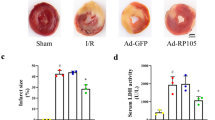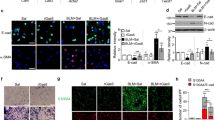Abstract
We wished to elucidate a potential role of the tumor necrosis factor-like weak inducer of apoptosis (TWEAK)/fibroblast growth factor-inducible molecule 14 (Fn14) axis in myocardial fibrosis. Stimulation of neonatal rat cardiac fibroblasts (CFs) with TWEAK could increase CFs numbers and collagen synthesis. Conversely, when CFs were pretreated with siRNA against Fn14, induction of cell proliferation and collagen synthesis by TWEAK were inhibited. Pretreatment with TWEAK on CFs induced activation of the nuclear factor-kappaB (NF-кB) pathway and subsequently increased the production of metalloproteinase-9 (MMP-9). Cell treatment with siRNA against Fn14 led to inhibition of the NF-кB pathway. Additionally, after stimulation of cell with ammonium pyrrolidine dithiocarbamate, cell proliferation and collagen synthesis induced by NF-кB and the upregulation of MMP-9 production were inhibited. The present study suggested that the TWEAK/Fn14 axis increased cell proliferation and collagen synthesis by activating the NF-кB pathway and increasing MMP-9 activity. This axis may be important for regulating myocardial fibrosis.









Similar content being viewed by others
References
Xu X, Pang J, Yin H et al (2007) Hexarelin suppresses cardiac fibroblast proliferation and collagen synthesis in rat. Am J Physiol Heart Circ Physiol 293:H2952–H2958
Spinale FG (2002) Matrix metalloproteinases: regulation and dysregulation in the failing heart. Circ Res 90:520–530
Leask A (2010) Potential therapeutic targets for cardiac fibrosis: TGF-beta, angiotensin, endothelin, CCN2, and PDGF, partners in fibroblast activation. Circ Res 106:1675–1680
Burkly LC, Michaelson JS, Hahm K et al (2007) TWEAKing tissue remodeling by a multifunctional cytokine: role of TWEAK/Fn14 pathway in health and disease. Cytokine 40:1–16
Wiley SR, Cassiano L, Lofton T et al (2001) A novel TNF receptor family member binds TWEAK and is implicated in angiogenesis. Immunity 15:837–846
Petitbarat M, Rahmati M, Serazin V et al (2011) TWEAK appears as a modulator of endometrial IL-18 related cytotoxic activity of uterine natural killers. PLoS ONE 6:e14497
Ando T, Ichikawa J, Wako M et al (2006) TWEAK/Fn14 interaction regulates RANTES production, BMP-2-induced differentiation, and RANKL expression in mouse osteoblastic MC3T3-E1 cells. Arthritis Res Ther 8:R146
Dogra C, Changotra H, Wedhas N et al (2007) TNF-related weak inducer of apoptosis (TWEAK) is a potent skeletal muscle-wasting cytokine. FASEB J 21:1857–1869
Brown SA, Richards CM, Hanscom HN et al (2003) The Fn14 cytoplasmic tail binds tumour-necrosis-factor-receptor-associated factors 1, 2, 3 and 5 and mediates nuclear factor-kappaB activation. Biochem J 371:395–403
Han S, Yoon K, Lee K et al (2003) TNF-related weak inducer of apoptosis receptor, a TNF receptor superfamily member, activates NF-kappaB through TNF receptor-associated factors. Biochem Biophys Res Commun 305:789–796
Winkles JA (2008) The TWEAK-Fn14 cytokine-receptor axis: discovery, biology and therapeutic targeting. Nat Rev Drug Discov 7:411–425
Campbell S, Burkly LC, Gao HX et al (2006) Proinflammatory effects of TWEAK/Fn14 interactions in glomerular mesangial cells. J Immunol 176:1889–1898
Ebihara N, Nakayama M, Tokura T et al (2009) Expression and function of fibroblast growth factor-inducible 14 in human corneal myofibroblasts. Exp Eye Res 89:256–262
Mustonen E, Sakkinen H, Tokola H et al (2010) Tumour necrosis factor-like weak inducer of apoptosis (TWEAK) and its receptor Fn14 during cardiac remodelling in rats. Acta Physiol (Oxf) 199:11–22
Jain M, Jakubowski A, Cui L et al (2009) A novel role for tumor necrosis factor-like weak inducer of apoptosis (TWEAK) in the development of cardiac dysfunction and failure. Circulation 119:2058–2068
Ocaranza MP, Diaz-Araya G, Carreno JE et al (2004) Polymorphism in gene coding for ACE determines different development of myocardial fibrosis in rats. Am J Physiol Heart Circ Physiol 286:H498–H506
Gagnon C, Legault F, Geraldes P et al (2004) Diverse effects of Ace inhibitors and angiotensin II receptor antagonists on prevention of cardiac hypertrophy and collagen distribution in spontaneously hypertensive rats. Int J Cardiol 97:373–381
Li YY, Feng YQ, Kadokami T et al (2000) Myocardial extracellular matrix remodeling in transgenic mice overexpressing tumor necrosis factor alpha can be modulated by anti-tumor necrosis factor alpha therapy. Proc Natl Acad Sci 97:12746–12751
Eberhardt W, Huwiler A, Beck KF et al (2000) Amplification of IL-1 beta-induced matrix metalloproteinase-9 expression by superoxide in rat glomerular mesangial cells is mediated by increased activities of NF-kappaB and activating protein-1 and involves activation of the mitogen-activated protein kinase pathways. J Immunol 165:5788–5797
Vellaichamy E, Khurana ML, Fink J et al (2005) Involvement of the NF-kappaB/matrix metalloproteinase pathway in cardiac fibrosis of mice lacking guanylyl cyclase/natriuretic peptide receptor A. J Biol Chem 280:19230–19242
Saitoh T, Nakayama M, Nakano H et al (2003) TWEAK induces NF-kappaB2 p100 processing and long lasting NF-kappaB activation. J Biol Chem 278:36005–36012
Daoud S, Schinzel R, Neumann A et al (2001) Advanced glycation end products: activators of cardiac remodeling in primary fibroblasts from adult rat hearts. Mol Med 7:543–551
Chuang YY, Tran NL, Rusk N et al (2004) Role of synaptojanin 2 in glioma cell migration and invasion. Cancer Res 64:8271–8275
Girgenrath M, Weng S, Kostek CA et al (2006) TWEAK, via its receptor Fn14, is a novel regulator of mesenchymal progenitor cells and skeletal muscle regeneration. EMBO J 25:5826–5839
Sanz AB, Sanchez-Nino MD, Izquierdo MC et al (2009) Tweak induces proliferation in renal tubular epithelium: a role in uninephrectomy induced renal hyperplasia. J Cell Mol Med 13:3329–3342
Novoyatleva T, Diehl F, van Amerongen MJ et al (2010) TWEAK is a positive regulator of cardiomyocyte proliferation. Cardiovasc Res 85:681–690
Jakubowski A, Ambrose C, Parr M et al (2005) TWEAK induces liver progenitor cell proliferation. J Clin Invest 115:2330–2340
Vince JE, Chau D, Callus B et al (2008) TWEAK-FN14 signaling induces lysosomal degradation of a cIAP1-TRAF2 complex to sensitize tumor cells to TNF-alpha. J Cell Biol 182:171–184
Tran NL, McDonough WS, Savitch BA et al (2005) The tumor necrosis factor-like weak inducer of apoptosis (TWEAK)-fibroblast growth factor-inducible 14 (Fn14) signaling system regulates glioma cell survival via NF-kappaB pathway activation and BCL-XL/BCL-W expression. J Biol Chem 280:3483–3492
Min KJ, Lee JT, Joe EH et al (2011) An IkappaBalpha phosphorylation inhibitor induces heme oxygenase-1 (HO-1) expression through the activation of reactive oxygen species (ROS)-Nrf2-ARE signaling and ROS-PI3 K/Akt signaling in an NF-kappaB-independent mechanism. Cell Signal 23:1505–1513
Li YY, McTiernan CF, Feldman AM (2000) Interplay of matrix metalloproteinases, tissue inhibitors of metalloproteinases and their regulators in cardiac matrix remodeling. Cardiovasc Res 46:214–224
Li YY, Kadokami T, Wang P et al (2002) MMP inhibition modulates TNF-alpha transgenic mouse phenotype early in the development of heart failure. Am J Physiol Heart Circ Physiol 282:H983–H989
Bauters C, Lamblin N, Mc Fadden EP et al (2003) Influence of diabetes mellitus on heart failure risk and outcome. Cardiovasc Diabetol 2:1
Krenning G, Zeisberg EM, Kalluri R (2010) The origin of fibroblasts and mechanism of cardiac fibrosis. J Cell Physiol 225:631–637
Brown RD, Ambler SK, Mitchell MD et al (2005) The cardiac fibroblast: therapeutic target in myocardial remodeling and failure. Annu Rev Pharmacol Toxicol 45:657–687
Sun Y, Kiani MF, Postlethwaite AE et al (2002) Infarct scar as living tissue. Basic Res Cardiol 97:343–347
Zlokovic BV (2006) Remodeling after stroke. Nat Med 12:390–391
Chaturvedi RR, Herron T, Simmons R et al (2010) Passive stiffness of myocardium from congenital heart disease and implications for diastole. Circulation 121:979–988
Bover LC, Cardo-Vila M, Kuniyasu A et al (2007) A previously unrecognized protein–protein interaction between TWEAK and CD163: potential biological implications. J Immunol 178:8183–8194
Dogra C, Hall SL, Wedhas N et al (2007) Fibroblast growth factor-inducible 14 (Fn14) is required for the expression of myogenic regulatory factors and differentiation of myoblasts into myotubes. Evidence for TWEAK-independent functions of Fn14 during myogenesis. J Biol Chem 282:15000–15010
Chorianopoulos E, Heger T, Lutz M et al (2010) FGF-inducible 14-kDa protein (Fn14) is regulated via the RhoA/ROCK kinase pathway in cardiomyocytes and mediates nuclear factor-kappaB activation by TWEAK. Basic Res Cardiol 105:301–313
Dogra C, Changotra H, Mohan S et al (2006) Tumor necrosis factor-like weak inducer of apoptosis inhibits skeletal myogenesis through sustained activation of nuclear factor-kappaB and degradation of MyoD protein. J Biol Chem 281:10327–10336
Li H, Malhotra S, Kumar A (2008) Nuclear factor-kappa B signaling in skeletal muscle atrophy. J Mol Med (Berl) 86:1113–1126
Hayden MS, Ghosh S (2004) Signaling to NF-kappaB. Genes Dev 18:2195–2224
Cuenca J, Goren N, Prieto P et al (2007) Selective impairment of nuclear factor-kappaB-dependent gene transcription in adult cardiomyocytes: relevance for the regulation of the inflammatory response in the heart. Am J Pathol 171:820–828
Yang M, Wu J, Martin CM et al (2008) Important role of p38 MAP kinase/NF-kappaB signaling pathway in the sepsis-induced conversion of cardiac myocytes to a proinflammatory phenotype. Am J Physiol Heart Circ Physiol 294:H994–H1001
Yepes M (2007) TWEAK and the central nervous system. Mol Neurobiol 35:255–265
Potrovita I, Zhang W, Burkly L et al (2004) Tumor necrosis factor-like weak inducer of apoptosis-induced neurodegeneration. J Neurosci 24:8237–8244
Li H, Mittal A, Paul PK et al (2009) Tumor necrosis factor-related weak inducer of apoptosis augments matrix metalloproteinase 9 (MMP-9) production in skeletal muscle through the activation of nuclear factor-kappaB-inducing kinase and p38 mitogen-activated protein kinase: a potential role of MMP-9 in myopathy. J Biol Chem 284:4439–4450
Awad AE, Kandalam V, Chakrabarti S et al (2010) Tumor necrosis factor induces matrix metalloproteinases in cardiomyocytes and cardiofibroblasts differentially via superoxide production in a PI3Kgamma-dependent manner. Am J Physiol Cell Physiol 298:C679–C692
Han YP, Tuan TL, Wu H et al (2001) TNF-alpha stimulates activation of pro-MMP2 in human skin through NF-kappaB mediated induction of MT1-MMP. J Cell Sci 114:131–139
Meiners S, Hocher B, Weller A et al (2004) Downregulation of matrix metalloproteinases and collagens and suppression of cardiac fibrosis by inhibition of the proteasome. Hypertension 44:471–477
Xia L, Shen H, Lu J et al (2011) TRAF2 and cIAP2 involve in TWEAK-induced MMP-9 production in fibroblast-like synoviocytes. Rheumatol Int 32:281–282
Polavarapu R, Gongora MC, Winkles JA et al (2005) Tumor necrosis factor-like weak inducer of apoptosis increases the permeability of the neurovascular unit through nuclear factor-kappa B pathway activation. J Neurosci 25:10094–10100
Acknowledgments
This study was supported by grants from the Key Technologies R & D Program of Shandong Province (grant number 2007GG10002014) and the Natural Science Foundation of Shandong Province (Y2007C073).
Conflicts of interest
No conflicts of interest are declared by the authors.
Author information
Authors and Affiliations
Corresponding author
Additional information
Hui-Na Chen and De-Jin Wang contributed equally to this study.
Rights and permissions
About this article
Cite this article
Chen, HN., Wang, DJ., Ren, MY. et al. TWEAK/Fn14 promotes the proliferation and collagen synthesis of rat cardiac fibroblasts via the NF-кB pathway. Mol Biol Rep 39, 8231–8241 (2012). https://doi.org/10.1007/s11033-012-1671-3
Received:
Accepted:
Published:
Issue Date:
DOI: https://doi.org/10.1007/s11033-012-1671-3




